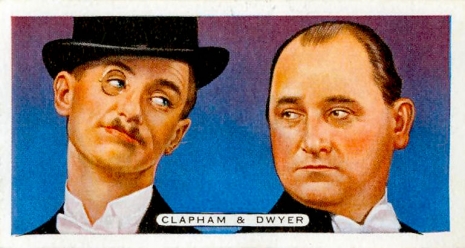Hay for Horses Beef or Mutton
A 'Surrealist Alphabet': As explained by two comedians in 1934

File under "K" for Quaint.
I took a wrong turning looking for the Surrealist Alphabet. I took a first left then a second right and went twice around the Bily Mill roundabout before traveling six-minutes-past-eight up the 1010 North. I got there eventually, but to be frank, it wasn't the one I was looking for. This Surrealist Alphabet was like something that popped out of a Christmas cracker or maybe one of Alexa's jokes. It was a comic skit performed by the English comedy double-act Clapham & Dwyer from circa 1934.
Their version of the "Surrealist Alphabet" was originally written in 1929 and was more a mix of the Cockney alphabet, World War One slang, and a comic play on words than anything "surreal" and some of it won't make much sense to our younger readers, for example, "K for ancis" was Kay Francis—a Broadway and Hollywood star of the 1920s and 1930s. Or, "I for Novello" after Ivor Novello.
Clapham & Dwyer's alphabet began with "A for Horses":
A for 'orses (Hay for Horses)
B for Mutton (Beef or mutton)
C for th' 'ighlanders (Seaforth Highlanders)
D for ential (Differential)
E for Adam (Eve for Adam)
F for vessence (Effervesence)
G for police (Chief of police)
H for respect (Have respect)
I for Novello (Ivor Novello)
J for orange (Jaffa orange)
K for ancis (Kay Francis)
L for leather (Hell for leather)
M for sis (Emphasis)
N for lope (Envelope)
O for the garden wall (Over the garden wall)
P for relief (Pee for relief)
Q for music (Cue for music)
R for mo ('Arf a mo)
S for you (it's for you)
T for 2 (Tea for two)
U for films
V for la France (Viva la France)
W for a fiver (Double you for a fiver)
X for breakfast (Eggs for breakfast)
Y for God's sake (Why, for God's sake)
Z for breezes (Zephyr breezes)
Clapham & Dwyer were William Charles Clapham (1894–1959) and Bill Dwyer (1887–1943), two white-collar workers who chanced their luck in comedy and went on to become the first British double-act to achieve national fame on radio. Clapham played the silly upper-class twit in top hat and monocle, while Dwyer was his long-suffering straight man. Together they co-starred in a few films and were a regular fixture on the BBC Light Program. Their humor was gentle ribbing, which has not dated well, though they were banned from the airwaves for making an allegedly "smutty" joke which went something like this:
"What's the difference between a champagne cork and a baby?" asked Clapham. When his sidekick said he didn't know, back came the response: "A champagne cork has the name of the maker on it."
Hardly shocking let alone funny, but enough for "Auntie" to ban the pair. The past is a different country, everything is unbearable there…
What I find interesting about all of this is that two mainstream radio comedians could hitch a routine to then-nascent Surrealist movement and expect their audience to know what they were talking about and play along.
Broadcasting new comedy material was generally considered a no-no for comedians as many (like Clapham & Dwyer) only "had one act..and didn't want to give it away to the thousands listening in." In those days, one good routine could last a year or more on the music hall circuit.
Clapham & Dwyer made their "Surrealist Alphabet" skit last for around five years touring the provinces but they eventually put it onto disc around 1934. Now you too can hear (suffer through?) what André Breton and his pals all missed out on.
Previously on Dangerous Minds:
Noel Coward performing 'Mad Dogs and Englishmen,' 1955
James Earl Jones recites the Alphabet on Sesame Street
Source: https://dangerousminds.net/comments/a_surrealist_alphabet_as_explained_by_two_comedians
Post a Comment for "Hay for Horses Beef or Mutton"